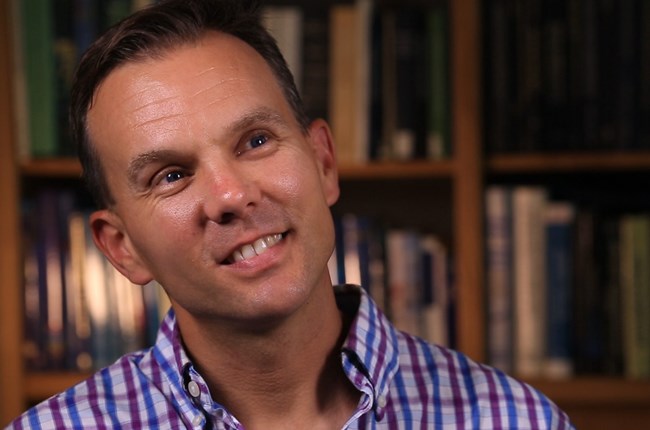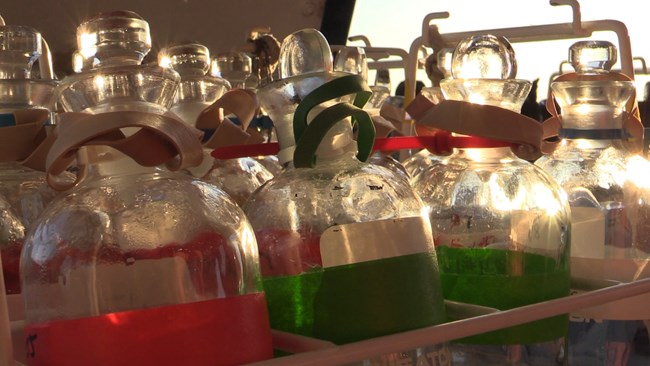Last updated: January 27, 2022
Article
Keys to Tomorrow: Chris Gobler studies storm impacts, resilience, and restoration opportunities in coastal parks
Many of the enduring visual impressions of Hurricane Sandy are those of destruction—inundated subway stations, shredded boardwalks, flooded beach roads. The storm created great difficulties for many coastal communities from Florida to Maine. But Hurricane Sandy had another, less acknowledged facet—its power to alter degraded ecosystems and to move coastal communities toward resilience.
For Chris Gobler, whose ancestors came though Ellis Island and settled in coastal Manhattan and Brooklyn, bearing witness to coastal change is an experience stitched into his heritage. He understands how the various faces of Hurricane Sandy sometimes seem at odds with one another. Now a fourth generation Long Islander himself and a professor in the School of Marine and Atmospheric Sciences at Stony Brook University, Gobler examines water quality change in coastal ecosystems and its effects on keystone species, or species that have an outsized influence over the fate of an ecosystem. Ultimately, Gobler hopes to refine our understandings of complex storm impacts and illuminate sound options for restoration and resilience.

Ryan Anderson
Along the south shore of Long Island lies Great South Bay, a 151 square-mile estuary that has been plagued by brown tides, or harmful algal blooms, since 1985. But before that, it was economically important. “They say that in 1980, two out of three hard clams eaten on the east coast of the U.S. came from Great South Bay,” Gobler says. And long before that, when Gobler’s ancestors settled in New York, there had been an abundance of oysters. “They’re all gone now,” he says. When water quality degraded, so did shellfish populations and the shellfishery itself. For decades, the water has looked sludgy.
Nearby, Jamaica Bay, New York, is the largest salt marsh within New York City limits. Part of Gateway National Recreation Area, Jamaica Bay likewise once supported a large oyster population. But hundreds of millions gallons of treated waste water dumped daily into Jamaica Bay has decimated the oyster population and resulted in harmful algal blooms.

Sarah Gulick
Long before Hurricane Sandy, Gobler was already conducting research on water quality in the region. Then as now, his research focused on informing efforts to improve water quality, efforts which, if successful, could also help restore ecologically and economically important shellfish populations. Even so, Hurricane Sandy changed Gobler’s research in some ways. Out of the storm emerged a resource, as unexpected as it is essential to the success of restoration efforts and resilience research: recognition.
Great South Bay: Storm Impacts, Resilience Research, and Recognizing Change
When Hurricane Sandy occurred, no northeast storm in living memory quite compared with it. Almost immediately, Long Islanders observed dramatic changes in the color and water clarity of the eastern parts of Great South Bay. Subsequent research has shown that the wilderness breach that occurred in Fire Island National Seashore produced changes in water flow, water mixing, and circulation patterns in the bay due to the now open exchange of seawater between the ocean and the bay.
Before the formation of the breach, Gobler estimates that it took months for water from the eastern parts of the bay to move out through the ocean inlet at the far west extent of Fire Island. In short, water circulation prior to Hurricane Sandy was “very sluggish,” he says, and this further exacerbated the impacts of harmful brown tides. Now that the wilderness breach allows a free flow of water between ocean and bay near the eastern end of the island, Gobler says, “The water seems to exchange almost within a day.” As a consequence, the wilderness breach seems to have disrupted the chronic harmful algal blooms in some parts of Great South Bay, offering a glimmer of hope to those who bore witness to the havoc brown tides wrought on the bay and surrounding communities.

Ryan Walace
The wilderness breach is also speeding the growth rate of hard clams in Great South Bay, and Gobler suspects that, with the right restoration efforts, the newly improved water quality could support a resurgence of shellfish populations.
Of the wilderness breach, Gobler says, “We’re trying to understand how it may be potentially helping to bring back the fishery.” After several years of robust research in Great South Bay, both before and after Hurricane Sandy, Gobler’s data shows promising changes in specific pockets of the bay in salinity, temperature, the concentration of phytoplankton, the intensity of brown tides, levels of bacteria, and the growth of hard clams.
While nearly overnight changes in some locations seem to suggest possibilities for long-term management that may support a renewed, thriving ecosystem, Hurricane Sandy also heightened awareness and urgency around the question of how to adapt to coastal change—an urgency that, in turn, propelled research forward.

Ryan Anderson
“There is now the recognition that a lot of our coastal systems are not what they used to be,” Gobler says. “They’ve changed a lot, and because of that, human populations, coastal communities, are actually very vulnerable to these coastal storms. The exciting thing, though, is that—recognizing that—there is now a very high interest in making these coastal communities more resilient. So, it’s exciting to be contributing to research that may make our communities safer in the future.”
What would safety have to do with brown tides, water clarity, and shellfish? To answer this question, Gobler points to his research in Jamaica Bay, where major efforts are underway to restore oyster reefs.
Jamaica Bay: Restoration and Future-focused Resilience Studies
A successful restoration of oyster reefs in Jamaica Bay will help coastal communities, because in addition to supporting biodiversity in the ecosystem and enhancing water quality, oyster reefs act structurally to mitigate the impacts of storm surge. For years, Gobler has conducted research in Jamaica Bay that supports efforts to restore estuaries and develop robust shellfisheries.
“People are trying to restore Jamaica Bay because it’s really been a degraded ecosystem. And people are putting a lot of time, effort, and money into that,” Gobler says. “We want those restoration activities to be as successful as possible, and we need to inform all of those decisions with the best science.”

Sarah Gulick
With funding from the National Park Service (NPS) for post-Hurricane Sandy storm mitigation and resilience studies, Gobler has been able to expand and enhance this research. In his research lab in South Hampton, New York, teams of students, post-docs, and research technicians work under Gobler’s leadership to carry out studies that examine changes in coastal environments that are caused by human activities. In Jamaica Bay, this means doing complex science for a complex environment.
“Jamaica Bay is a very complicated ecosystem. So many things are changing at once,” Gobler says. “When we see something happen, we may not be sure why it’s happening. So we compliment observational science with experimental science.”
Observational science in this case refers to Gobler’s efforts to collect information about the bay directly. Gobler’s team conducts monthly surveys from a 44-foot research vessel. Sensors on the research vessel track temperature, salinity, pH, dissolved oxygen, carbon dioxide, and chlorophyll levels in the water. The team also regularly retrieves data from probes that continuously monitor water quality in the bay.
When Gobler and his team’s findings are unusual or unexpected, they run experiments to better understand what’s happening and why. For example, they observed that low oxygen levels and low pH, or acidification, were occurring at the same time. Gobler couldn’t explain this, so he and his team conducted experiments to figure out what could be causing the phenomenon. They understood that algal blooms deprive the water of oxygen, but the source of acidification was unclear, and it was particularly unusual to see these two conditions so in synch with each other.

Sarah Gulick
Experiments allow a more controlled environment for examining the relationships and processes at play in a complex environment. By testing one variable at a time, Gobler and his team learned that when algal blooms decay, they also produce carbon dioxide in the water, just as if they were exhaling. Carbon dioxide reacts with water to make it more acidic. By combining their observational data—information from the sensors and probes—with experiments, Gobler and his team learned that algal blooms are responsible both for low oxygen levels and low pH in Jamaica Bay.
With this discovery, Gobler has geared his team’s research toward learning the severity of the problem, including which parts of the bay are experiencing the combined low oxygen and low PH, when, and for how long. “That’s important information,” Gobler says, “because those are two stressors that are happening together, and they’re going to affect all the marine life in Jamaica Bay. And so, if we’re going to make informed decisions about how to restore that system, we need to really understand it.”
In addition to collecting data on water quality, Gobler and his team are running experiments to learn what parts of the bay should be targeted for shellfish restoration efforts, and which bivalve populations would be best suited to current and future conditions in the bay. In part, these experiments involve growing bivalves at different strategic locations in the bay and monitoring their growth.

Baranowski/NPS
Why do bivalves matter? According to Gobler, “One oyster can filter fifty gallons of water in a day. When you have a large population of filter-feeding bivalves, that can really have a big effect.” As keystone species, the vitality of bivalve populations has an overwhelmingly positive influence over the vitality of the entire ecosystem and nearly every living thing in it. Bivalve species found in Jamaica Bay include eastern oysters, ribbed mussels, and blue mussels. These species filter the water, thus combating harmful algal blooms, improving water quality, and promoting optimal conditions for submerged aquatic vegetation. They also provide habitat for other marine life. Ultimately, restoration of bivalve populations would be good for the ecosystem as a whole, good for coastal communities’ economies, and good for coastal dwellers contending with sea level rise and other effects of climate change.
As coastal communities anticipate more frequent and more intense coastal storms in the future, bivalves offer possibilities for resilience. Oyster reefs take shape as natural structures that can diminish the impacts of storm surge, and ribbed mussels, which grow in salt marshes, make salt marshes stronger. Gobler says, “We know that our ecosystems have changed, and we know they’re going to change further. We know storms are going to become more commonplace, and the storm surge is going to be even higher because we know sea level is rising. All these things are going to happen, no matter what, moving forward. That puts the onus on us to adapt and become more resilient, and try to make our estuaries resilient to these changes.”

Erin Finicane
This speaks to the broader impacts and value of Gobler’s NPS-funded research: it has real and significant benefits for communities that are looking for ways to prepare for the next coastal storm and to take appropriate action toward resilience. Doing so requires deep and scientifically sound understandings of the interconnections between us and the ecosystems we are part of and depend upon. Science is the first step.
“I’m convinced that the only way we’re going to get there is science and policy,” Gobler says. “Science can help make sure that money that is invested in restoring ecosystems is best spent. Without the science, it’s guesswork. If we can provide the science, maybe the policy can help us get there.”
Written by Jamie Remillard, Caroline Gottschalk Druschke, and Sarah Gulick (SEAcomm URI)
Tags
- fire island national seashore
- gateway national recreation area
- ncbn
- northeast coastal and barrier network
- gateway national recreation area
- gate
- fire island national seashore
- fiis
- jamaica bay
- great south bay
- hurricane sandy
- water quality
- coastal communities
- coastal resilience
- coastal parks
- shellfish
- inventory and monitoring division
